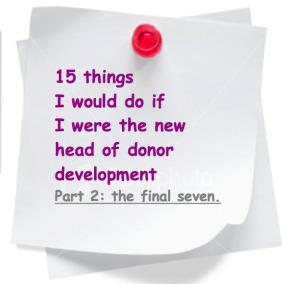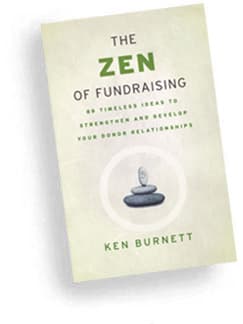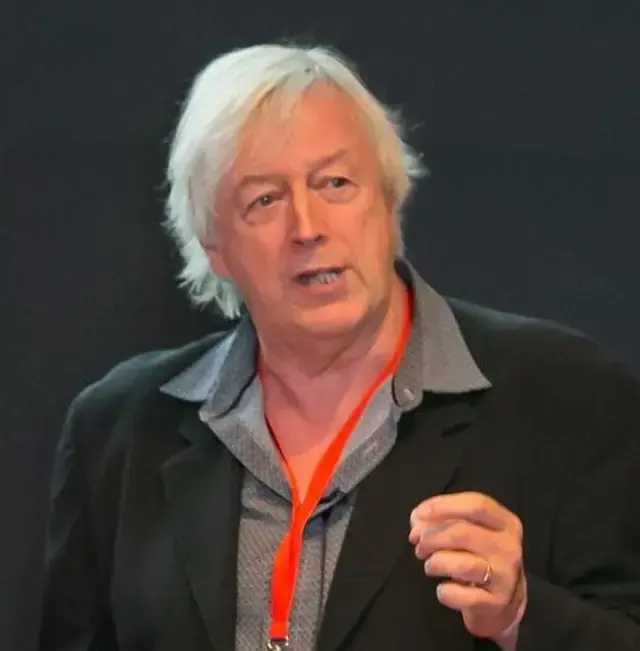15 things I would do if I were the new head of donor development, part 2
This list came about when a US journal for fundraisers asked me to imagine I’d just started in a new job, with a clean slate and sufficient resources to set about transforming the donor development function. It’s included here to help anyone in an even vaguely similar situation. And to help me set out my philosophy of donor development.
- Written by
- Ken Burnett
- Added
- July 11, 2011
Part2: the final seven.

These 15 strategies aren’t the only things I’d do. They may not even be the most urgent things I’d do, or even the most important. But they are the things I’d do that I think would have the most lasting impact, that would make the most difference to converting my imaginary donor development department from the under-funded, misunderstood appendage to the fundraising function that I found on joining the organization, into the finely honed, high-earning core activity that I’d like to leave behind me when, in the fullness of time, I move on to pastures new (you have to indulge me a little here, in this fantasy).
Anyway, here are the final seven. The first eight are already on SOFII.
9. I’d work on strategies that build our donors’ trust and confidence in us and our organization . I’d make our nonprofit a model of proactive accountability, to show we are effective and well-run
This means that in addition to producing the best, most involving, most welcome communications in all practical formats, I’d try to make our communications into models of good stewardship. I’d publish ‘the standards we set ourselves’ in our annual report. I’d offer donors a charter that sets out clearly our commitment to them, explaining how we propose to be excellent stewards of the funds they entrust to our care. I’d include volunteers and other key supporters and constituents in this too, as well as donors.
Transparent accountability isn’t just a duty, it’s an opportunity. Demonstrable good governance and open, proactive accountability will be hallmarks of the successful fundraising organization of the future. Increasingly donors expect nonprofits to be fully accountable and will come to demand ever more evidence of efficient and effective governance. But it will pay you if don’t wait for donors to ask. Demonstrate your good stewardship and commitment to full accountability at every opportunity. Invite and encourage comment and questions. That alone will reassure your donors.
The impact of good governance on fundraising can be profound and will grow in the future. I’d recommend to my colleagues that they read about the essentials of good governance in some of the books on the subject, including Kay Sprinkel Grace’s Overgoal and my own book on the subject, the Tiny Essentials of an Effective Volunteer Board, (published in 2005 by The White Lion Press Limited, London).
Fundraisers have to champion accountability and take it to their donors. As explained earlier the media are always happy to exploit any hint of poor management or inefficiency from nonprofits and the public are only too prepared to follow where journalists lead. Yet fundraisers usually have nothing to hide and lots to be proud of. Generally nonprofits do a lot better than the public thinks they do. We need to illustrate our effectiveness and efficiency clearly and to strongly champion them, rather than trying to keep our heads down and hoping questions will just go away. So I’d tell the others in my department
- Invite donors to ask questions. Make it easy for them.
- Show your donors ‘their file’. Offer your donors on-line access to their accounts and to any other information you hold on them.
- Promote your organization as financially prudent and well run (make sure first that it is). Invite donors to come and see for themselves.
- Make available to those donors that wish to have them, details of your financial systems, risk and impact assessment procedures and other techniques and systems of good governance. Circulate key audiences (staff, volunteers and donors who ask for them) with details of what happens at your board meetings, including full minutes (editing out anything of a genuinely sensitive or confidential nature, ie a disciplinary procedure). Many organizations now post highlights of board meetings on their Intranet or website. Donors, I am sure, will approve.
10. I’d focus on the major motivations that have attracted our donors to our cause in the first place. I’d try to understand these, and make the best possible use of them
Most organizations have access to several; often these are quite different from each other and from those that can be accessed by other organizations. After I had identified all of the main motivations that apply in my organization I’d make sure everyone else knows about them too. Then, I’d build strategies addressing these motivations and blend them into our future communications. For example, a nonprofit serving children with a disability may have donors who are there because of a professional connection, or because they feel sympathy or pity for the children, maybe they have a family member with this condition, or are angry that more isn’t being done, and so on. Creatively addressing these fundamental, yet very different and distinctive motivations will ensure our donors get more from their support of our cause. When this happens, I’m confident our fundraising results will rocket.
11. I’d have our donor database properly profiled at least once each year
We need to know our donor file inside out so we can make sure we have the most useful information on our donors, what they are doing and what they are thinking. This information has to be available to us at all times and in ways we can easily access. Very often organizations have lots of information on their donors but don’t know how to access it, or what to do when they have it, eg lifetime giving (LTG – a donor’s giving total to date) and lifetime value (LTV – what a donor will give you in his or her lifetime). I’d use this process to identify the real donors hidden within our file, so we could aim to ask fewer people for more money for better reasons. We would then combine this empirical information with all the other research data we have gathered to ensure that we are doing all we can optimise and grow all our donors’ lifetime values.
12. I’d offer donors and other supporters the chance to choose when and how often they hear from us and what they might want to hear about
Which do you think will work best? If we send our donors what we want them to have, or what they are willing and happy, or at least prepared, to receive? It’s the 90-degree shift again. Donors will always be more responsive if what we send them is what they want to receive. We’ll aspire to only send donors what interests them and what they’re most likely to respond to.
Giving donors the right choices will enable us to segment our donor file not just by the two traditional levels of segmentation, demographic characteristics and past behaviour, but by choice, the third level. We will continually ask our donors what they want and do our best to deliver it.
Giving customers choices has become known as permission marketing. A few far-sighted nonprofits have been practicing it for years and getting exceptional results. Nowhere is permission marketing more appropriate than for nonprofit fundraisers.
Our approach to fundraising communication would be driven by what interests and involves our donors. Giving donors choices is a perfect example of the 90-degree shift. Having made our organization and its offerings as interesting, appropriate and involving as possible, I’d be confident that donors would safely, reliably chose for themselves the level of closeness and the content that would most suit their interest in and capacity for involvement with our cause.
When this strategy starts to work I’ll try introducing other choices for our donors, so they can in effect choose their own personal communications programs. I know the technology that makes this possible is getting better and cheaper all the time. And I know donors give much more regularly and more happily if they feel their wishes are taken into account. So this is another area where I’ll be able to be 15 minutes ahead.
Then with this and all the other learnings I’ve gathered from the points in this list I’d structure a fundraising strategy that employs the best of current techniques and practices, focusing on fundraising that motivates rather than discourages my donors.
13. I’d create an environment where innovation and creativity can flourish, so I could readily develop appropriate products and propositions designed to suit our donors
It pays to offer donors appropriate products they will want to buy. These days if a nonprofit hasn’t got monthly giving, high value donor (HVD) and legacy products then it is already behind. Product design and development is a sophisticated field for fundraisers. Most new products fail and that’s as true in the nonprofit world as commercially. But that should never deter us from investing appropriately in new product development, or from learning and borrowing from the experience of others. A vast body of knowledge and experience has now been built up of what works and what doesn’t in fundraising, so this is a good area for creative plagiarism, for borrowing the best of what works for others.
Yet in the world our donors inhabit, lazy, lookalike fundraising abounds. Somewhere in the mists of time (or more likely, at a succession of quite recent fundraising seminars) fundraisers were taught and came to accept that there are fixed formulae to guide them, that to get the best responses we must slavishly follow the ‘right’ procedures, that to obtain maximum savings and optimum returns our communications have to fit a limited range of standard shapes, styles and sizes. That what works for one organisation will surely also work for another.
They were right, those teachers who propounded these wisdoms. (Though I suspect that many of the fundraising gurus who teach at seminars and workshops also own direct marketing and communications businesses that thrive when fundraisers all blindly follow the conventions of their trades.) Nevertheless fundraisers all want to minimise costs and maximise returns so by processes of testing and plagiarising we have all wound up copying pretty much what everyone else does. The result for our poor donors (and even our rich donors) is that they wind up getting piles and piles of requests that all look pretty much the same. Yet we know that the beginning of success is to be different, the beginning of failure is to be the same.
Averagely our donors are quite intelligent people. Ere long they begin to see through our techniques, which are generally pretty transparent, not to say often ham-fisted. Who was it that first imagined donors would be fooled for long by letters that start with that moronic salutation ‘Dear Friend’? (OK, Dr Thomas Barnardo, I have to suppose, whom I mention in The Zen of Fundraising. But I guess even he’d be astounded to find that nearly 120 years after he coined this bland generalisation we still trot it out daily, as if there were no permitted alternative. Are we sheep, or what?)
So maybe it isn’t sensible any longer to have mailings that look so obviously mass produced, with envelopes with addresses that show through windows, or carry prepaid bulk postage imprints and letters with lots of short paragraphs, underlining, indenting and inevitably all ending with at least one postscriptum (better known as the PS). We should acknowledge now that the majority of our donors and potential donors are perceptive enough to see through such artifice.
From any viewpoint, nonprofit organisations constantly need to be reviewing the products and propositions they offer donors, even if it’s just the continuing efficacy or otherwise of the basic proposition ‘give us your money’.
There’s ample evidence around to show that those organisations which have embraced R&D, as it might be called in corporate businesses, and offered their donors appropriate new products and propositions, have prospered disproportionately. Think of child and animal sponsorship, monthly donor schemes, bequest giving clubs and so on.
Think too of the prizes that might come to those who do things differently, who innovate, who stand out from the herd... Not just in format (it’s often quite hard to break from the conventions that have been imposed upon us); we can also be imaginative in offer and in audience and always in how we present our message, in creative treatment and in how we tell our stories.
No doubt, in fundraising it pays to be first, as I’m sure fundraisers down the ages will have known well. But it also pays to move on. Those organizations that first experimented in off-the-page advertising did spectacularly well in Britain in the 1950s and 60s. The pioneers of direct mail fundraising in the USA and UK during the 1970s and 80s built massive donor lists that are now the greatest of assets for these far-sighted fundraisers. Those first in telephone fundraising cleaned up, whereas the entrepreneurs who gave us direct dialog, better known in most of the world as face-to-face fundraising, very quickly and cost-effectively recruited hundreds of thousands of regular monthly donors and raised millions of dollars, pounds, or euros for the causes they represent. Those in the vanguard of the new communications revolution will most probably reap similar benefit.
Undeniably, there are glittering prizes for successful innovators in fundraising. But fundraisers also are a cautious lot and adequate budgets for research and development are not often to be found in the nonprofit world. This won’t do. Fundraisers have to innovate fearlessly and constantly. More alarming is the culture of ‘heads down’ that pervades, the fear of being different and the almost irresistible compulsion to be the same.
Given the urgency of our causes, such conservatism is unforgivable. We should reject totally a culture of caution and instead build for ourselves environments that are in constant turmoil, where change and invention are nurtured and encouraged, where innovation is honored, even revered and where ‘wrong’ is not necessarily a bad place to be. This may require a new approach to budgeting. The innovation culture has a totally different sense of failure to the operations culture. In the innovation culture each failure takes us a step closer to ultimate success. Donors need to understand this and to be a part of it. (They often are — and enthusiastically so. In America these generous, rich and far-sighted people are referred to as entrepreneurial donors, or even ‘philanthrepreneurs’. Maybe that is going a bit too far...)
I’m not suggesting we sink all of our resources into the search for innovation. Ten or even five per cent of net income would do. Actually, for most organisations even one per cent would be nice. Provided that along with the cash would come a commitment to change our thinking and to elevate innovation and all that goes with it to its proper place. If it’s really committed to be the best in this area, the serious nonprofit will regularly review those in charge of the innovation process, how it encourages staff to collaborate on product and service improvements, how it generates and captures new ideas, how it bounces back after a wrong decision and how it is doing in regard to competitors and their innovations. This is not an area for the faint-hearted.
14. I’d make our organization the best communicator anywhere
Effective communication important for fundraisers. So I’d study thoroughly the ever-increasing and improving options for the new customer relationship management (CRM) technology that’s just around the corner for fundraisers. At the right time for us, I’d invest prudently in it. These new communications systems (which in the future may not be called CRM because of the negative associations that often surround that term) will transform the way fundraisers deal with donors, just as the development of electronic databases transformed fundraising potential 20 years or so ago. But I’d hope not to forget that this leap forward will be less to do with technology, more to do with processes and much more to do with people. When installing donor databases some years back, many fundraising organizations got it badly and expensively wrong (for a variety of generally not very good reasons, largely to do with a failure to anticipate needs properly and a reluctance to invest sufficiently). I’d have a chance now to learn from the past and so get it right this time. I’d take the decision carefully and thoroughly of course. But I’d make sure I took it bravely, so that our organization could stay that all- important 15 minutes ahead. And so we could treat our donors exactly like we’d wish to be treated ourselves.
15. Finally, I’d give a little bit extra
To stand out, you have to be outstanding. So in fundraising it pays to go further than expected. My colleagues and I, therefore, would always offer a bonus particularly, but not exclusively, when dealing with donors one-to-one. We’ll have competitions to see who can come up with the most cost-effective and original ‘extra mile’ that we can go, for our donors.
© 2006 Ken Burnett
This ‘top tips’ list is an extract from The Zen of Fundraising by Ken Burnett, published by Jossey-Bass Inc, San Francisco, 2006.


















